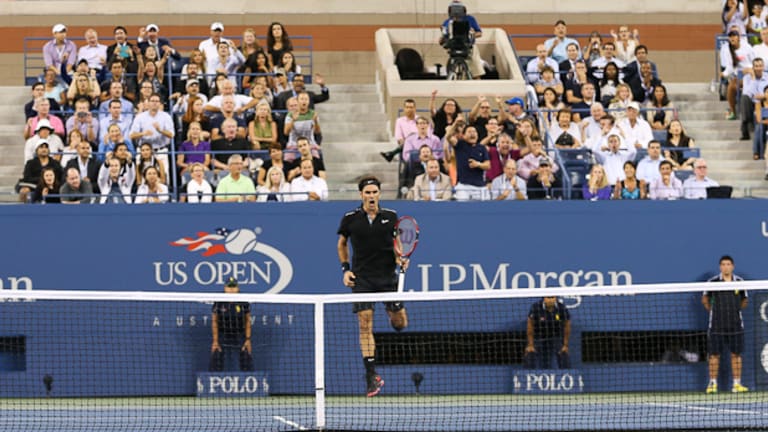NEW YORK—Roger Federer was asked after his five-set win over Gael Monfils on Thursday night what he had been thinking when he was down two match points in the fourth. Federer could have trotted out a classic players' cliché, like, “I was just trying to hit my spot with my serve.” Or he could have spouted some Tennis Psychology 101, like, “I was trying to treat it like any other point.”
Instead, Federer, a little punchy with joy and relief, let loose with a giggling, stream-of-consciousness spiel about the conversation he had conducted in his head as stepped to the line to serve at 4-5, 15-40. Apparently, he had begun by telling himself, a little dejectedly, “This is the last point, man.” By the time he was done, he sounded even less confident than when he had started: “Just let him have it,” Federer instructed himself before he served.
You know what they say: Whatever works. By that point, Federer had tried pretty much everything else against Monfils. He had sliced his backhand low and softly to try to break up the Frenchman's rhythm early, and lost the first set. He had come with an all-out attack at the start of the second set, but that lost that one, too. He had worked hard to fire himself up in the third and fourth sets, and had found some success by draping himself all over the net. Yet here he stood, a point from defeat against a man he had beaten in seven of their nine previous matches.
“I was getting on his serve, you know,” Federer said, recounting his frustrations, “but I was just not hitting my forehand very well. Then on the serve I start to either over serve or whatever I was doing. It wasn’t working.”
“He started chipping very low,” Monfils said. “I think I handled it good. So then he stick with longer points. It was 50-50, and then he try to come to the net very often. It was a bit better for him. Then he suddenly start to mix everything. That’s why he’s the greatest player, because he can do everything.”
Federer won this match because he wouldn’t stop looking for a solution to the maddeningly gifted and unpredictable Monfils. The fact that Monfils is so famously flaky likely helped give Federer the motivation to keep trying, and the belief that something would eventually work. Federer finally found his solution at the net, and in that sense, if this wasn’t his best performance of 2014, it was the most representative of his resurgence this year.
